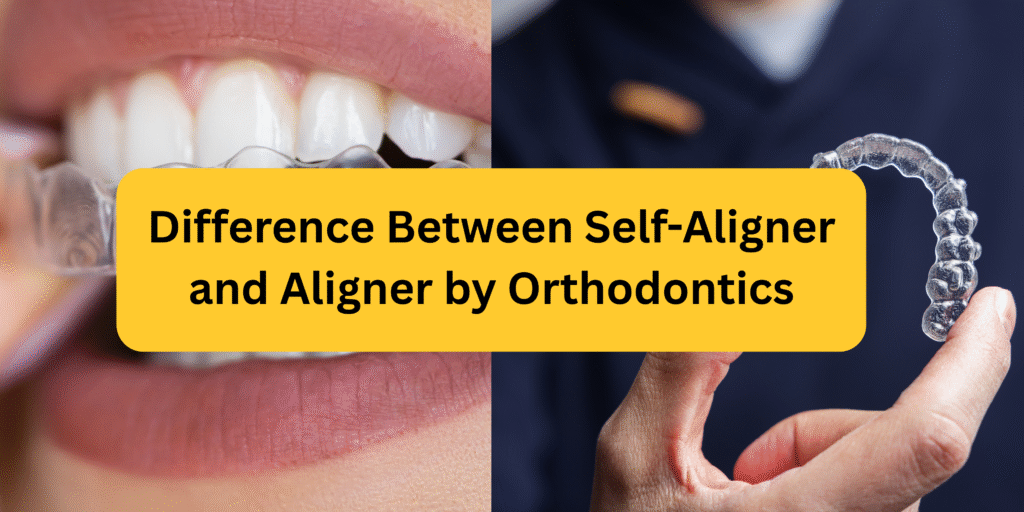Clear aligners have become one of the most popular options for people who want to straighten their teeth discreetly. While many professional orthodontists provide aligner treatment, there has also been a rise in “self-aligner” kits—aligners ordered online without direct supervision from a dentist or orthodontist.
At first glance, self-aligners may seem cheaper and more convenient, but the differences between self-aligners and orthodontist-supervised aligners are significant. Choosing the right option can make the difference between achieving a healthy, lasting smile—or facing serious dental problems.
Let’s break down the key differences:
- Initial Check-Up
Self-Aligner: Usually requires you to take impressions at home or send in photos of your teeth. There’s no full dental check-up, X-rays, or professional oral evaluation. This means underlying dental issues like cavities, gum disease, or jaw problems may go unnoticed.
Orthodontist Aligner: Begins with a thorough in-person examination, including X-rays and digital scans. This ensures your teeth, gums, and jaw are healthy before treatment starts, reducing risks later.
- Treatment Planning
Self-Aligner: Treatment plans are typically software-generated with little to no input from a dental professional. These generic plans often ignore important aspects like bite correction or long-term stability.
Orthodontist Aligner: An orthodontist designs a personalized treatment plan, considering not only teeth alignment but also bite, jaw function, and overall oral health. This leads to safer, more predictable results.
- Supervision During Treatment
Self-Aligner: No in-person monitoring. You receive all aligners upfront and follow instructions on your own.
Orthodontist Aligner: Includes regular check-ups, progress tracking, and adjustments if necessary. This ongoing supervision ensures your teeth move safely and as planned.
- Suitability for Different Cases
Self-Aligner: Can only handle very mild cases, such as slight crowding or small gaps. Complex issues like overbite, underbite, or jaw misalignment are not suitable.
Orthodontist Aligner: Can treat mild, moderate, and even complex cases effectively because of professional planning and supervision.
- Risk Factor
Self-Aligner: Higher risk of complications, including gum problems, incorrect tooth movement, or even tooth loosening. Since there’s no supervision, small issues can become serious over time.
Orthodontist Aligner: Risks are minimized through regular monitoring and adjustments by a trained specialist.
- Treatment Adjustments
Self-Aligner: No scope for corrections if something goes wrong mid-treatment. You’re stuck with the initial plan.
Orthodontist Aligner: Orthodontists can modify treatment, order new aligners, or adjust the plan as your teeth move, ensuring accuracy throughout.
- Accuracy of Results
Self-Aligner: Limited accuracy due to lack of professional involvement. Teeth may shift partially, leaving you with an incomplete or unsatisfactory result.
Orthodontist Aligner: Provides highly accurate results thanks to advanced technology, scans, and expert planning.
- Cost Considerations
Self-Aligner: Lower upfront cost, but hidden long-term expenses often arise if treatment fails, leading to corrective procedures.
Orthodontist Aligner: Higher initial investment, but safe, predictable, and long-lasting results save you from costly complications in the future.
- Treatment Time
Self-Aligner: Often marketed as delivering faster results, but progress can be unpredictable and relapse is common.
Orthodontist Aligner: Provides a more reliable treatment timeline with steady, controlled tooth movement.
- Results and Long-Term Stability
Self-Aligner: May achieve partial correction, but results are unstable and teeth often shift back due to poor retainer planning.
Orthodontist Aligner: Ensures stable, long-lasting results with a proper retention plan (custom retainers) to keep your smile aligned for years.
Final Thoughts
When it comes to straightening your teeth, professional expertise matters. While self-aligners may appear convenient and cost-effective, the risks far outweigh the benefits. Without proper diagnosis, planning, and supervision, you could end up with poor results—or worse, long-term dental damage.
On the other hand, aligners provided by orthodontists are backed by science, technology, and years of training. They ensure safe, accurate, and stable results tailored to your specific needs.
If you’re considering aligners, invest in your oral health by consulting a certified orthodontist. A healthy, confident smile is worth doing right the first time.

